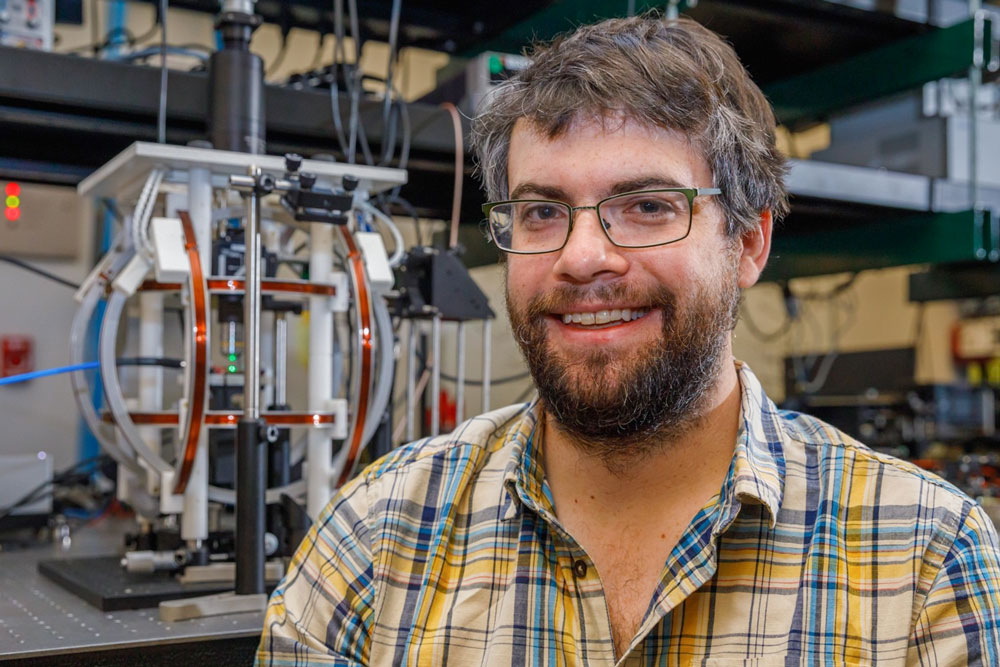
Diamonds are a scientist’s best friend. That much is at least true for physicist Andy Mounce, whose work with diamond quantum sensors has earned him a DOE Early Career Research Award.
The scientist in Sandia’s Center for Integrated Nanotechnologies specializes in making microscopic sensors to try to understand the nature of quantum materials and their electrons’ behavior. Andy is an expert in creating nitrogen-vacancy defects in the artificial diamonds, which are extremely sensitive to the electric and magnetic fields at a nanoscale.
“With these quantum sensors we can study basic properties of low dimensional quantum materials, such as superconducting phases, magnetic phases,” he said. “A quantum material can be anything from a nanostructure to a large material that just has electrons that interact with each other very strongly. The distinguishing property of a quantum material is that their behavior is defined by quantum mechanics, so not your typical copper conductor.”
Understanding changes at a quantum level
Using the five-year Early Career Research Award, Andy hopes to understand the topological phase transitions of quantum materials.
“A topological phase breaks the classic paradigm of how materials traditionally go through phase transitions; they don’t behave like simple liquid-to-solid transitions. Furthermore, topological phases are really hard to detect, particularly at the limit of single atomic layer materials,” he said. “If we can harness topological phases in quantum materials, we can use them for a new generation of quantum computers or energy efficient devices.”
Andy believes his diamond quantum sensors can bring unique insight into the signatures of topological phases in 2D materials, providing new insights into their emergence and basic properties.
Between a rock and a hard place
But there is another aspect to the work Andy and his team will carry out: enabling diamond quantum sensing in extreme conditions of low temperatures, high magnetic fields and very high pressures.
“We can create a diamond anvil cell and actually use two diamonds and push a quantum material together really hard,” Andy said. “We’ll get the material to very high pressure to reveal new phases in quantum materials with our nitrogen-vacancy quantum sensor right at the action, at the surface of the diamond. These are challenging experiments for which the Center for Integrated Nanotechnologies, a DOE Office of Science user facility operated by Sandia and Los Alamos national laboratories, will be one of the few places that will have the capabilities and expertise to perform with qualified users.”
Building a career at Sandia
Andy did not start out trying to understand the fundamental building blocks of the world around us.
“When I was younger, I liked both chemistry and physics. In my undergraduate work I was doing both of those, but I really liked the mathematical framework that physics obeys. It really drew me in,” he recalled. “I like to build things, which is exactly what experimental physics provides. You really have to be interested in instrumentation and methodology of how to take measurements in these extreme conditions.”
Andy earned his doctorate in condensed matter physics from Northwestern University, studying quantum materials through more traditional methods. He was hired at Sandia in 2015 to work on quantum computation but then got the opportunity to combine these experiences and join CINT in 2018.
“Here at the Center for Integrated Nanotechnologies, you always have to be looking ahead of the game and provide unique and new capabilities. You really need to be pushing the envelope of scientific techniques,” he said.
Andy thanked the first members of his team, Jake Henshaw and Pauli Kehayias, who helped him develop a successful quantum sensing program. He also credits his friend and mentor Mike Lilly with encouraging his efforts to think beyond the traditional. He believes that Mike helped him achieve this Early Career Research Award through his support and mentorship. Andy also recognizes the foundational support from his wife, Sandia software systems engineer Heidi Uphoff. “I’m really lucky that our paths crossed.”
“It’s a very big honor and there’s a lot of qualified people out there, so I feel very lucky and honored to be considered in the same category as them,” Andy said of other Early Career Research Award honorees. “I’m excited for the opportunity to even further build our quantum sensing program at CINT.”
The bigger picture of quantum study
Andy hopes to have CINT’s quantum sensing continually expand to users who would not normally have access to the equipment and expertise needed to perform these experiments on quantum materials.
“After the project is over, we’re going to have new techniques to make quantum sensors and new capabilities to use quantum sensors,” he said. “We’re also going to have new discoveries of how quantum materials work as seen by those quantum sensors. With these new capabilities and discoveries, the sky is the limit.”